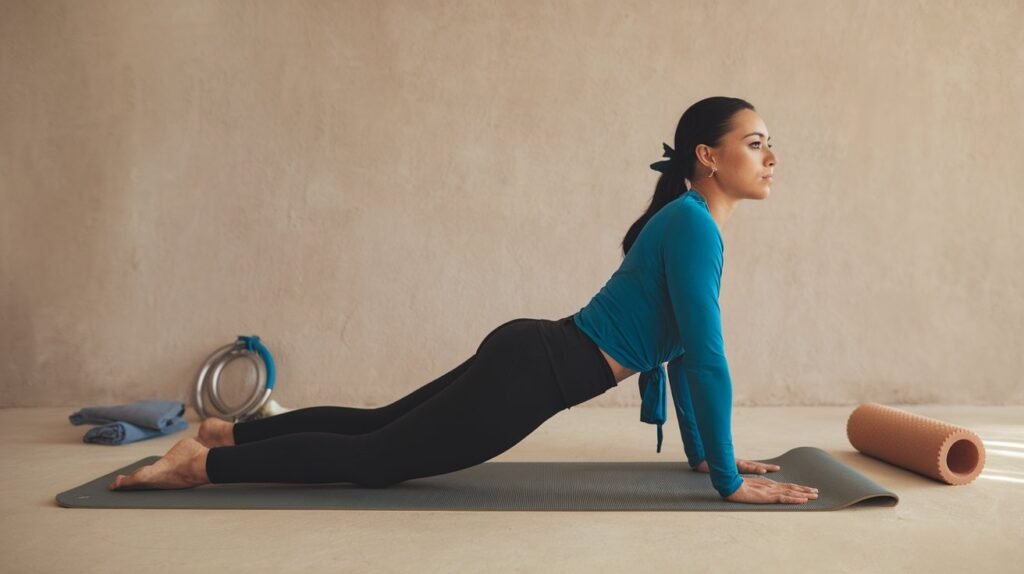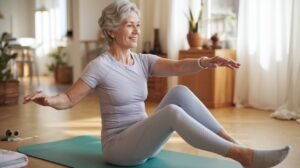Caregiving is one of the most physically and emotionally demanding roles a person can undertake. Recent studies reveal that 68% of caregivers suffer from chronic back pain caused by constant lifting, bending, and hunching over beds or wheelchairs. Even more alarming, 72% report experiencing severe emotional burnout from the relentless stress of tending to loved ones’ needs. These statistics paint a clear picture: caregivers are silently sacrificing their own health while supporting others, Pilates for Caregivers.
This is where Pilates for Caregivers becomes not just helpful, but essential. Unlike traditional workouts that demand time and energy caregivers don’t have, Pilates offers a sustainable solution. Its focus on mindful movement addresses both the physical strain of caregiving—like counteracting that characteristic “caregiver hunch”—and the mental toll through its meditative breathing techniques. Research from UCLA confirms the power of this approach, showing that caregivers who incorporated short daily movement breaks saw a remarkable 23% reduction in cortisol levels. More than just exercise, Pilates becomes a form of self-preservation for those who spend their days preserving others.

5 Essential Pilates Exercises for Caregivers
Between medication schedules, doctor’s appointments, and daily care tasks, finding time for self-care can feel impossible. That’s why we’ve designed these five Pilates exercises specifically for time-crunched caregivers. Each can be done in minutes, requires no equipment, and fits naturally into your caregiving routine.
1. Doorway Decompression
After hours of hunching over to assist your loved one, this simple stretch works wonders. Stand in an open doorway and place your hands on the frame at shoulder height. Gently lean forward until you feel a stretch across your chest and shoulders. Hold for 30 seconds while taking deep breaths. This counteracts the rounded shoulder posture that develops from constant caregiving tasks.
2. Kitchen Counter Plank
While waiting for tea to brew or meals to heat up, turn your kitchen into a mini-studio. Place your hands on the counter and walk your feet back until your body forms a straight line from head to heels. Hold this modified plank for 30 seconds to strengthen your core and relieve pressure on your lower back.
3. Seated Spinal Twist
You probably spend much of your day sitting—during medical appointments, while providing bedside care, or during rare moments of rest. Make that time work for you by practicing seated twists. Sit tall in any chair, place your right hand on the left knee, and gently twist to look over your left shoulder. Hold for three breaths, then switch sides. This improves spinal mobility for all those times you need to reach for supplies or assist your loved one.
4. Silent Footwork
During those long nights of vigil-keeping, when even leaving the room isn’t an option, try this subtle movement. While sitting or standing near the bed, lift your toes while keeping your heels planted, then reverse to lift your heels. Alternate these movements slowly to improve circulation and maintain ankle mobility without disturbing your loved one’s rest.
5. 3-Minute Meditation Roll Down
When stress feels overwhelming, this combination of movement and breath can work miracles. Stand with feet hip-width apart. Inhale deeply, then exhale as you slowly roll your spine down, one vertebra at a time. Let your arms and head hang heavy. Inhale to roll back up, stacking each bone carefully. Repeat three times, imagining you’re rolling away tension with each exhale.
Creating a Sustainable Self-Care Routine
The key for caregivers isn’t finding extra time—it’s making the most of the moments you already have. Here’s how to weave these exercises into your existing routine:
Morning: While waiting for the coffee to brew, do 2 minutes of doorway stretches. The caffeine and movement will work together to energize you for the day ahead.
Midday: Use meal preparation time for kitchen counter planks. Three 30-second holds while the microwave runs can significantly reduce afternoon back pain.
Evening: During the medication routine, incorporate seated twists and footwork. These subtle movements help release the day’s accumulated tension.
Night: Before collapsing into bed, take 90 seconds for the meditation roll down. This creates a physical and mental separation between caregiving time and your precious rest time.
Why Our App is a Caregiver’s Best Friend
We designed our Pilates Workout at Home App with caregivers’ unique needs in mind:
Micro-Workouts
With 28 programs under 7 minutes, you can squeeze in self-care during stolen moments. The voice-guided option lets you practice with eyes closed when you’re too exhausted to look at a screen.
Adaptable Reminders
The app intelligently adjusts to your unpredictable schedule. After particularly chaotic days, it suggests gentler routines. If you’ve been sitting too long, it prompts you with a quick stretch.
Community Support
Connect with other caregivers in our private discussion groups. Share tips, celebrate small victories, or simply vent to people who truly understand. Our “I Survived Today” badges honor the invisible work you do.
Real Caregiver Testimonial
“During my husband’s hospice care, the app’s 3AM ‘Quiet Calm’ routine was my lifeline. Those few minutes of guided breathing helped me survive the hardest months of my life.” — Marisol G., 2-year caregiver
You Can’t Pour From an Empty Cup
Caregiving is a marathon, not a sprint. By investing just 10 minutes a day in these Pilates practices, you’re not being selfish—you’re ensuring you have the strength, mobility, and emotional resilience to keep providing care without sacrificing your own health.
Download the Pilates Workout at Home App today and give yourself the gift of sustainable self-care. Because the world needs caregivers who care for themselves too.










Leave a Comment